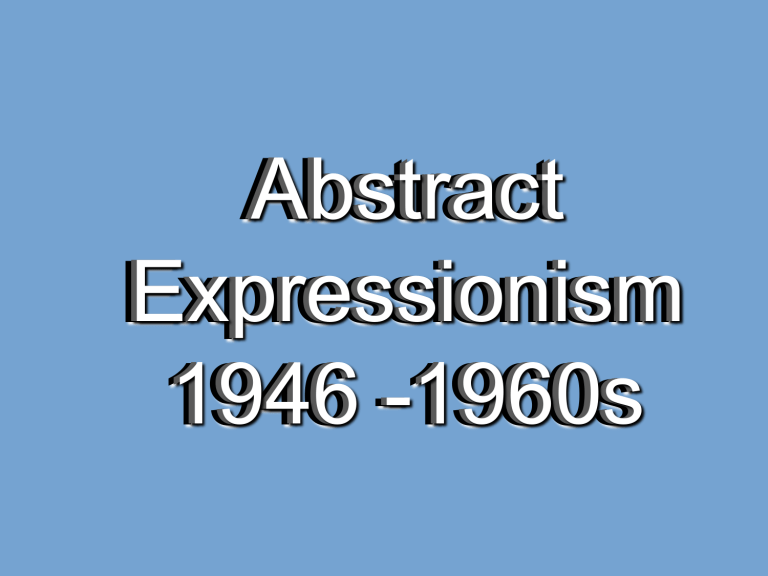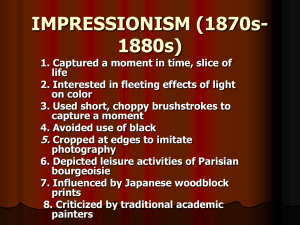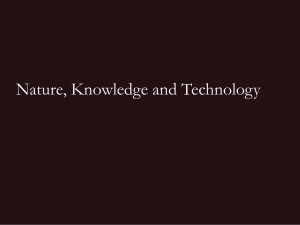Abstract Painting
advertisement

Abstract Abstract Expressionism Expressionism 1946 -1960s -1960s 1946 When and How Did It Start? • • • • Years right after World War II Small group of painters New York City Previous surrealism art movement What are the Movement’s Roots? • New York City – mainly – but other American cites such as San Francisco and California • The origin of the actual concept of Abstract Art are usually said to have come from the work of Kandinsky in Russia. What Is Abstract Expressionism? • Abstract Expressionism is a form of art in which the artist expresses him or herself purely through the use of form (shape) and colour. • It is non-representational or non-objective art, which means that there are no concrete objects represented. • The invention and development of abstraction, that is, art that does not imitate the appearance of things, is among the twentieth century’s most important contributions to the history of art. • Abstract expressionism has never ended it has just changed through technological advances and medium development. • Some Abstract expressionists in contemporary times add plastic polymers to their paints which creates texture which does not deteriorate over time, unlike Jackson Pollock’s classic ‘Blue Poles.’ What Caused it to Start? There are different opinions on how it began; - Russian Artist Wassily Kandinsky - People stopped tolerating the social realism after the war and instead switched Harmonie Tranguille to Abstraction (Quiet Harmony) by Wassily Kandinsky. The original masterpiece oil painting was painted in 1924. The forefather Kandinsky Winter landscape with Church Kandinsky was an expressionist artist from the Der Blaue Reiter era. Kandinsky’s works were humanitarian, spiritual and non-political. Abstract Expressionism can be divided Into 2 main facets Action or Gestural Paints and Colour Field The return of Thornton Willis reflects the enduring legacy of abstract painting. Action or Gestural Painting Artists Techniques and Media Use; The artists typically applied paint rapidly and with force to their huge canvases in an effort to show feelings and emotions, they painted gesturally, non-geometrically, sometimes applying paint with large brushes and sometimes dripping or even throwing paint onto canvas. Action or Gestural Painting Jackson Pollock (1912-1956) Willem de Kooning (1904-1997) Hans Hofmann (1880-1966) Franz Kline (1910-1962) Mark Tobey (1890-1976) Philip Guston (1913-1980) Adolph Gottlieb (1903-1974) Critical Appraisal Artist 1 – Jackson Pollock’s Blue Poles •The principals of design of this piece are neither planned or organized. •Random gesture and movement to make a completely un-constructed art piece. •Use of dripping of paint creates broad textual lines of many intersecting colours. •Randomness is the intention, when we critically analysis this paint we can see the strong vertical formations •Vertical lines dominate the piece and are positioned in a balanced manner with symmetry. •Harmonious to look at and rhythm occurs with the movement of elements that flow across the canvas. •No form, however, even with his randomness he has created tree-like shapes giving the suggestion of a forest. •This is a significant painting Jackson Pollock (1912-1956) The media referred to Jackson Pollock as “Jack the Dripper Jackson Pollock, Birth, c. 1941 Oil on canvas, 116.4 x 55.1 cm Jackson Pollock, Night Mist, 1945 Oil on canvas Jackson Pollock, Painting (Silver over Black, White and Red), 1948 Painting on paper mounted on canvas, 61 x 80 cm Jackson Pollock, The Deep, 1953 Paint on canvas, 220.4 x 150.2 cm Willem de Kooning (1904-1997) Willem de Kooning, Light in August, 1946 Oil & enamel on canvas, 139.8 x 105.5 cm Willem de Kooning, Seated Woman, 1952 Pastel, pencil, and oil on two hinged sheets, 30.8 x 24.2 cm Willem de Kooning, Woman V, 1952-53 oil and charcoal on canvas, 154.5 x 114.5 cm, NGA Willem de Kooning, The Visit, 1966-1967 Oil on canvas, 152.4 x 121.9 cm Hans Hofmann (1880-1966) Hans Hofmann, Pompeii, 1959 Oil on canvas, 214.0 x 132.7 cm Hans Hofmann, The Gate, 1959–60 Oil on canvas, 190.5 x 123.2 cm Hans Hofmann, To Miz-Pax Vobiscum, 1964 Oil on canvas, 196.5 x 212.4 cm Franz Kline (1910-1962) Franz Kline, New York, N.Y., 1953 Oil on canvas, 200.6 x 129.5 cm Franz Kline, Painting Number 2, 1954 Oil on canvas, 204.3 x 271.6 cm Franz Kline, Untitled, 1957 Oil on canvas, 200 x 158.5 cm Franz Kline, C & O, 1958 Oil on canvas, 195.6 x 279.4 cm Mark Tobey (1890-1976) Mark Tobey, Cloud, 1954 Tempera on paper, 21 x 20 cm Mark Tobey, Untitled, 1958 Tempera on paper, 20.96 cm x 11.43 cm Mark Tobey, Lake, 1959 Gouache on paper, 24.7 x 31.7 cm Mark Tobey, Advance of History, 1964 Gouache and watercolour on paper, 65.2 x 50.1 cm Philip Guston (1913-1980) The Bauhaus, Tea set, 1930 Philip Guston To B.W.T.,1952 Oil on canvas,123.2 x 130.8 cm Philip Guston, Zone, 1953-54 Oil on canvas 116.8 x 121.9 cm Philip Guston, The Return, 1956-8 Oil on canvas, 178.1 x 199.1 cm Adolph Gottlieb Adolph Gottlieb, Apaquogue, 1961 oil on canvas, 183.5 x 229.2 cm Adolph Gottlieb, Centrifugal, 1961 Gouache on paperboard, 38 x 25.4 cm Cy Twombly (1928- ) Cy Twombly, The Italians, 1961 Oil, pencil and crayon on canvas,199.5 x 259.6 cm) Cy Twombly, Untitled, 1967 Oil and crayon on canvas, 147.3 x 177.8 cm Cy Twombly, Untitled (Bolsena), 1969 oil-based house paint, wax crayon, and graphite on canvas, 203.2 x 244.2 cm Colour Field Painting Characterised by large areas of a more or less flat single colour. It differed from Abstract Expressionism in that these artists eliminated both the emotional, mythic or religious content of the earlier movement, and the highly personal and painterly or gestural application associated with it. Colour Field Painting Clyfford Still (1904-1980) Mark Rothko(1903-1970) Barnett Newman (1905-1970) Ad Reinhardt (1913-1967) Helen Frankenthaler (1928-) Jules Olitski (1922-) Critical Appraisal Artist 2 – Clyfford Still’s Untitled •Concerned mostly with colour. •Uninterested in form and content •The size of the art work is extremely significant as the enormous blocks of colour have an effect on the viewer. •Some art critics describe the effect of these paintings as creating a vibration which stimulates emotion. •No line or recognizable forms are intended by the artist. •Although composition does not follow traditional arrangements the breaks in colour – as we can see in this piece – are still harmonious to the eye and have a sense of rhythm. 1956 Oil on canvas, 92.1 x 266.1 cm Clyfford Still (1904-1980) 1951-N, 1951 oil on canvas, 234.5 x 175.6 cm Untitled, 1956 Oil on canvas, 92.1 x 266.1 cm Mark Rothko(1903-1970) Mark Rothko, Untitled (Violet, Black, Orange, Yellow on White and Red), 1949 Oil on canvas, 207 x 167.6 cm Mark Rothko, Number 2, 1954 Oil on canvas, 291.5 x 207 cm Mark Rothko, Number 20, 1957 Oil on canvas, 233.0 x 193.0 cm NGA Mark Rothko, Sienna, Orange & Black on Dark Brown,1962 Oil on canvas, 193 x 175 cm Barnett Newman (1905-1970) Barnett Newman, Dionysius, 1949 oil on canvas, 170.2 x 124.5 cm Barnett Newman, Achilles, 1952 oil and acrylic resin on canvas, 241.6 x 201 x 5.7 cm Barnett Newman, The Third, 1962 oil on canvas Clyfford Still, 1951-N, 1951 oil on canvas, 234.5 x 175.6 cm Ad Reinhardt (1913-1967 Ad Reinhardt, Abstract Painting, c. 1951-2 Oil on canvas, 203.2 x 106.7 cm Ad Reinhardt, Black Painting No 34, 1964 Oil on canvas, 153.0 x 152.6 cm Helen Frankenthaler (1928-) Helen Frankenthaler, Wales, 1966 Acrylic on canvas, 287.5 x 114.4 cm Helen Frankenthaler, Coral Wedge, 1972 Acrylic on canvas, 207 x 118.1 cm Helen Frankenthaler, Viewpoint II, 1979 Acrylic on canvas, 206.38 X 240.03 cm Jules Olitski (1922-) Jules Olitski, Summer Seizure, 1966 Oil on Canvas, 238.7 x 81.2 cm Jules Olitski, Prince Patutsky's Command, 1966 synthetic polymer paint on canvas, 418.2 x 179.0 cm NGA Impact on Art Today; • Abstract paintings and art have influenced many artist to not feel like that have to paint portraits and landscapes, but they can paint what they feel and make their work mean something to them. • There are many artists that still create abstract art today, and now they have taken the ideas of it and applied it to other things, such as architecture.







